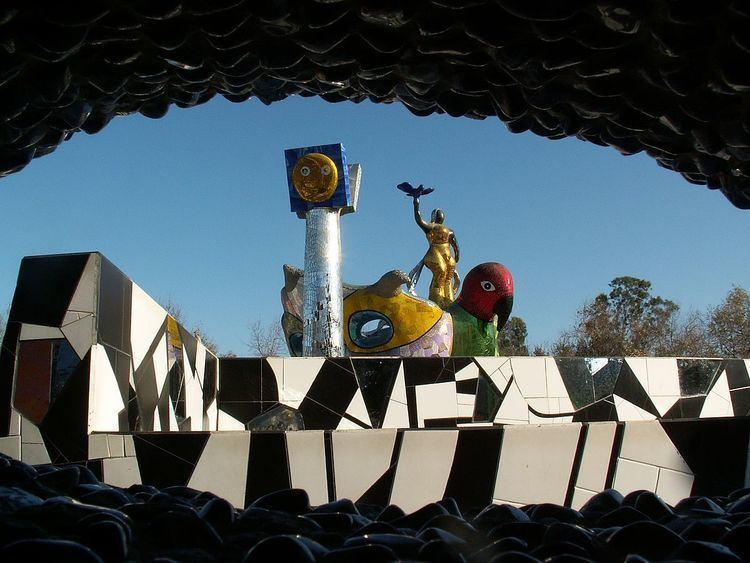Phone +1 760-839-4691 | Year 2003 | |
 | ||
Address 3333 Bear Valley Pkwy, Escondido, CA 92025, USA Hours Closed today MondayClosedTuesday9AM–12PMWednesdayClosedThursday9AM–12PMFridayClosedSaturdayClosedSundayClosedSuggest an edit Similar Kit Carson Park, Felicita County Park, Giardino dei Tarocchi, Grape Day Park, Stravinsky Fountain | ||
Queen califia s magical circle
Queen Califia's Magical Circle is a sculpture garden located in Escondido, California. It is one of the last works of French artist Niki de Saint Phalle. The garden is named after Califia, the fictional warrior queen of the mythical Island of California, and inspired by California's rich history and culture. It includes a circular wall and maze entryway, ten large sculptures, and native trees and shrubs planted both inside the plaza and around the outer wall.
Contents
- Queen califia s magical circle
- Queen califia s magical circle escondido
- Materials and construction
- Sculptural features
- Queen Califia Egg Fountain and Eagle Throne
- Totem figures
- References
The garden is part of a 12-acre habitat in Kit Carson Park's Iris Sankey Arboretum, and was opened to the public on October 26, 2003.
The sculpture garden is only open the second Saturday of each month while undergoing repairs.
Queen califia s magical circle escondido
Materials and construction
The garden's wall is covered mostly in Mexican pebble stones, while the snakes and other sculptures are clad in many thousands of hand-cut glass, ceramic and stone mosaic tiles. Some wall segments are also decorated with ceramic plaques engraved with Native American rock art and other symbols, as well as handprints and signatures from Saint Phalle's family and art team. Queen Califia herself is embellished with hand-cut mirrored glass, while the fountain uses gold leaf glass and is controlled by a solar-powered pump.
The wall, maze and sculptures were constructed using polystyrene encased in a polyurethane skin, with applied fiberglass coating over a steel armature. The designs were based on Saint Phalle's original maquettes, with the aid of computer modeling and prototyping. The artist began work on Queen Califia in 2000. After her death, completion of the work was overseen by Niki's granddaughter, Bloum Cardenas, and her longtime assistants. This was Saint Phalle's last major project.
Sculptural features
A rippling 400-foot "snake" wall, ranging between four and nine feet in height, forms the perimeter of the garden. Colorful mosaic serpent sculptures are positioned along the top of the wall. The single entrance opens onto a "maze" whose short walls are covered in black, white and mirrored mosaic tiles. After navigating the maze, visitors can enter the courtyard where the ten primary sculptures are located.
The garden houses a total of ten freestanding sculptures—Califia, the fountain and the eight totems—which are influenced by an eclectic combination of Native American, pre-Columbian and Mexican art.
Queen Califia, Egg Fountain and Eagle Throne
In the center of the garden is an 11-foot mosaic sculpture of Queen Califia in gold glass armor, standing atop a 13-foot eagle and raising a bird above her head. Visitors can walk between the eagle's legs and into a domed temple adorned with celestial symbols and plaques from another sculpture garden by Saint Phalle, the Tarot Garden. In the middle of the plaza is a golden egg-shaped fountain, which represents both Califia's magical reign over the sea and the birth-death-transformation cycle that serves as a recurring theme in Saint Phalle's works.
Totem figures
Eight totem sculptures measuring between 11 and 21 feet tall surround Califia. They are covered with stylized symbols, creatures, and animals that played important roles in the mythologies of various indigenous peoples. The eagle is an especially prominent part of the work, as it figures significantly in Native American and indigenous Mexican legends. It also recurs frequently in Saint Phalle's other works.
